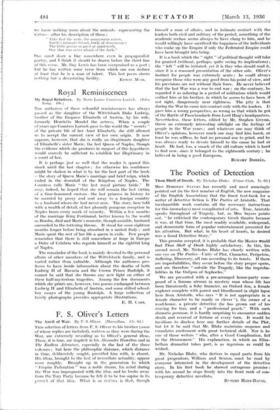Royal Reminiscences
Tia: authoress of these colourful reminiscences has always passed as the daughter of the WitteLsbach Duke Ludwig, brother of the Empress Elizabeth of Austria, by his wife, formerly Henriette Mendel the actress. When a couple I if years ago Countess Larisch gave to the world the " secrets " of the private life of her Aunt Elizabeth, she still allowed us to accept the current view of her own origin. It now appears, however, that she is really an illegitimate daughter of Elizabeth's sister Marie, the last Queen of Naples, though the evidence which she produces in support of this hypothesis would scarcely be sufficient to establish her illegitimacy in a court of law.
It is perhaps just as well that the reader is spared this shock until the last chapter ; for otherwise his confidence might be shaken in what is by far the best part- of the book —the story of Queen Marie's marriage and brief reign, which ended in the downfall of the Kingdom of Naples. The Countess calls Marie " the last royal picture bride." It may, indeed, be hoped that she will remain the last victim of a time-honoured custom—the last princess in history to be married by proxy and sent away to a foreign country to a husband whom she had never seen. The story, here told with a wealth of detail, of her gloomily pompous reception in Naples bears every mark of veracity. Within a few months of the marriage King Ferdinand, better known to the world as Bomba, died and Marie's neurotic, though amiable, husband succeeded to the tottering throne. It stood for some eighteen months longer before being absorbed in a united Italy ; and Marie spent the rest of her life a queen in exile. Few people remember that there is still somewhere at large in Europe a Duke of Calabria who regards himself as the rightful king of Naples.
The remainder of the book is mainly devoted to the personal affairs of other members of the Wittelsbach family, and is varied rather than valuable. Although the authoress pro- fesses to have inside information about the deaths of both Ludwig II of Bavaria and the Crown Prince Rudolph, it cannot be said that she throws any new light on either of these half-mysterious tragedies. Among the few documents which she prints are, however, two poems exchanged between Ludwig II and Elizabeth of Austria, and some stilted school- boy essays of the young Rudolph. A large collection of family photographs provides appropriate illustrations.
E. H. CARR.














































 Previous page
Previous page